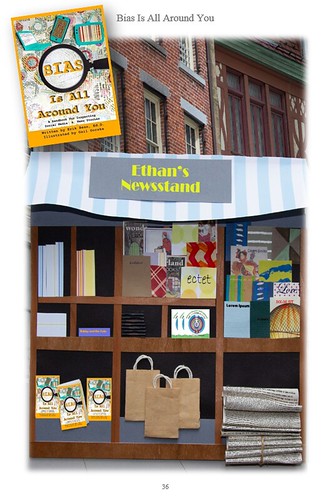Note: This book? It's an incredibly important read—and tool—for educators, parents, and students.

Bias Is All Around You! Can you separate fact from fiction to safeguard your mental health? Let this handbook be your guide for inspecting all the information you are exposed to in social media today. If you cannot properly assess information bias, it could:
1. Lead you to follow a false cause
2. Leave you feeling foolish
3. Tarnish your credibility
4. Attract the wrong people
5. Create undue stress
6. Compromise your values
7. Harm your mental health
These undesirable outcomes need not occur! It's time to read between the lines and assess bias now.
A byproduct of the misinformation associated with the 2020 US election, the pandemic, and uncivil unrest, Bias Is All Around You includes a foreword by Tim Vos, Ph.D. Director, School of Journalism, Michigan State University. All revenue goes to benefit the Ethan Bean Mental Wellness Foundation, a Michigan 501(c)3 public charity that author Erik Bean started in 2019 after losing his 17 year old son to mental illness. Find the book, and more information, at: https://biashandbook.com/

This is an excerpt from Bias is All Around You: Chapter 4: How to Test Journalistic Sources

Some sources of information are categorized as journalistic. Prior to the internet, the traditional news mediums were the only sources of official news other than independent magazines and association newsletters. The various news agencies decided based on their own arbitrary analysis of stories which ones should be publicly released. Thus, they were known as the gatekeepers of the news. Much has been studied about how such journalistic operations prioritize news releases and how prominently they cover such stories (Shoemaker & Vos, 2009). Then, as today, we hope they rigorously take a non-bias approach to accuracy in their stories. But all news must be assessed and vetted for their ownership can frequently change hands or side with politics or be tied to funding or other conflicts of interest. Therefore, these 6 tests can help discern any gray areas of bias that might otherwise affect the authenticity of their work:
1. Is the source under scrutiny a reliable one? Has it existed for many years? Is its agenda hidden?
2. Do their views appear to be freely expressed regardless of the financial support they receive?
For example, a national news network like NBC reports on a controversial issue associated with the entity Peloton (an exercise bike company) it owns (Stump, 2019). We question, can such a conflict of interest affect the rigor of the reporting?
3. Does this journalistic source represent the best in journalistic training? Do they employ people who have been professionally trained as a reporter? Do they maintain neutrality and mirror the news, not editorialize it?
4. Does the source suppress sensationalism known as yellow journalism? Tabloids employ yellow journalism by dramatizing and exaggerating to capture their audience.
5. Is the source searchable in a library database?
6. Do such outlets typically take on a one-sided political view?
Be mindful, as of late 2020 six corporations, Comcast, NBCUniversal, Disney, CBS, Viacom News Corporation, and AT&T, control approximately 90 percent of all media outlets in America (Louise, 2020). Objectivity and some bias can be present in any of these news divisions and their subsidiaries.
The above tests help to discern gray areas and levels of bias that can affect the authenticity of published pieces. These tests should be applied to avoid hasty generalization in sharing information, whether it was propagated from an individual or any of the entities within the 7 bias sources. Be aware that quantity of postings or claims does not substantiate news. Quality of the claims, who represents them, under what bias sources they are made, and whether such claims are already vetted by many are keys to contributing to everyday successful informational analysis.

About the author and illustrator:
Because mental health issues have adversely affected his family and so many others around him, Erik Bean is passionate about helping others. This lifelong effort includes coauthoring the 2019 award-winning Ethan's Healthy Mind Express: A Children's First Mental Health Primer book.
Illustrator Gail Gorske is a master paper arts professional whose award-winning illustrations include nature photography and those found in Ethan's Healthy Mind Express. Her images have inspired generations to critically think and cross all boundaries of of race, religion, gender, and nationalities.
All information contained herein courtesy and copyright Erik Bean
